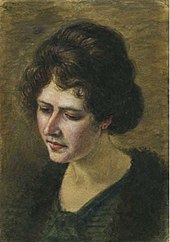Franz Mohr (painter)
Franz Mohr ( December 24, 1877 in Müschede - October 1, 1943 in Bad Oeynhausen ) was a German painter and writer.
Life
Franz Mohr was a son of the teacher in Müschede, Franz Mohr (September 2, 1852 in Momberg - November 28, 1880 in Müschede) and his wife Anna Maria Sophia, née Stockebrand (September 28, 1854 in Hachen - December 8, 1881 in Müschede ). He and his brother Karl Egon grew up with their mother's family in Hachen after their mother's death. The mother died giving birth to the third child, daughter Sophia, who also died a few days later. The father had died about a year earlier. Hubert Mohr was a son of the brother.
Mohr first studied in Berlin from 1898 to 1900 with Friedrich Stummel and then from 1905 to 1907 at the Academy in Munich, among others with Nikolaus Gysis , Carl von Marr , Ludwig von Löfftz and, above all, with Franz Defregger , whose work Mohr only referred to there Academy beckoned. From 1905 to 1907 he made several study trips. Then Mohr moved back to Berlin, where he attended the Berlin Art Academy and also took private lessons from Lovis Corinth and again from Friedrich Stummel. After completing his studies, he worked for two years as a teacher and proofreader at Anton Ažbe's painting school in Munich and also worked as an actor and art critic. In the years before the war, Mohr worked successfully in southern Russia. Here he not only portrayed the landed gentry of the area, but also created religious monumental paintings. His large-format picture of Christ Noli me tangere was shown at the art exhibition in Budapest in 1910 and was very well received there.
Mohr spent the last months before the war in Germany, the outbreak of the First World War prevented a return to Russia. In 1915 he volunteered for the war. During the trench warfare on the Somme , he was buried in 1917 and seriously wounded. After that he was no longer fit for duty and had to be treated in various hospitals until the spring of 1919. His brother was also badly wounded by poison gas and could no longer pursue his original job as a carter for the rest of his life, but instead work as an invalid as a warehouse clerk. After his release from the hospital, Mohr lived in Bad Oeynhausen for follow-up treatment from April 1919, where he also stayed. He never recovered from the injuries and remained sickly, unstable, and depressed for the rest of his life. Since he was unsuccessful with his art despite the certification of a great talent, he turned increasingly to poetry. His poetry often has religious content, even more often he was devoted to the places he considered his home. His artistic ambitions can be seen, for example, in the design of memorials for the victims of the First World War. In 1926 an exhibition was dedicated to Mohr in Bad Oeynhausen, at which some of his works were shown.
Mohr's estate is in the Müscheder local archive. At his own request, he was buried on October 5, 1943 in Hachen, the formative place of his childhood. He had never started a family of his own.
Web links
- On the history of the Mohr family. In: Müscheder Blätter. 42nd episode, January 2012, pp. 327–338 (PDF; 1.0 MB)
| personal data | |
|---|---|
| SURNAME | Mohr, Franz |
| BRIEF DESCRIPTION | German painter and writer |
| DATE OF BIRTH | December 24, 1877 |
| PLACE OF BIRTH | Müschede (Arnsberg) |
| DATE OF DEATH | October 1, 1943 |
| Place of death | Bad Oeynhausen |


